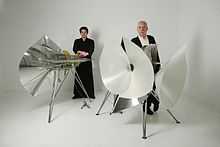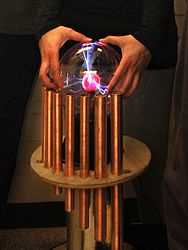Cristal baschet


The Cristal Baschet is an acoustic musical instrument belonging to the friction idiophone category. The vibration of its individual elements produces tones by means of friction. Metal rods are embedded in a heavy plate to form the elements. Each metal rod has an attached glass rod. The glass rod is gently stroked with a wet finger to produce sound. The metal rod's length, weight and position at the equilibrium point determine the sound's pitch.
The vibration of the rod with greater amplitude and weaker pressure is transmitted into the metal fitting. This causes a transformation in the vibrations and the shape of the wave produced. The vibrations propagating through the metal have a high pressure and a weak amplitude. This amplification in pressure is the result of fiberglass cones that are fixed in a wood frame alongside a tall, cut-out metal part in the shape of a flame. "Whiskers," placed on the side of the instrument, amplify high-pitched sounds.
The Cristal Baschet is also known as the Crystal Organ and the Crystal Baschet. The range of a concert Cristal is 5 octaves. The sound of the Cristal has nothing to do with the glass harmonica.
The Cristal baschet was invented in 1952 by the French instrument makers and artists Bernard and Francois Baschet. The Baschet brothers specialized in creating sculptures that could be played to produce music. They invented the inflatable guitar, an aluminium piano, and then created an "educational instrumentarium" for the purpose of giving young people exposure to musical concepts.
The Cristal Baschet was developed around the same time as musique concrète (Avant-Garde musical style introduced by Pierre Schaeffer and Pierre Henry), Electro-Acoustic music and early Moog synthesizers. The Cristal Baschet produces music similar in style to these other musical forms, but through purely acoustic means; no electrical amplification is involved.

Repertoire
The Cristal Baschet has been used for several different applications, such as ballet music, songs, film and theater music, jazz, rock, electronic music, improvisation, tales, and contemporary music.
The following composers have used this instrument:
- François Bayle
- Thomas Bloch[1]
- Michel Deneuve
- Luc Ferrari
- Cliff Martinez
- Jean-Michel Jarre
- Beatriz Ferreyra
- Guy Reibel
- Etienne Rolin
- Mike Sheridan
- Toru Takemitsu
- Michel Redolfi
- Daft Punk ("Motherboard" in Random Access Memories).
Recent compositions have been written by the following composers:
- Sir Roger Steptoe
- Horatiu Radulescu
- Bruno Giner
- Eric Fisher
- Emmanuel Séjourné
- Alain Voirpy
- Alain Labarsouque
- Jean-Michel Hasler
- Jean Philippe Calvin
- Frederic Bousquet
- Marc Antoine Millon.
In the United Kingdom, the most familiar musical piece to be played on the Cristal Baschet is "Maneche," composed by Jacques Lasry. This has been used for over twenty years as the opening theme to the Granada Television children's program Picture Box."
See also
External links
- (http://www.hopensemble.eu/)
- (http://www.youtube.com/user/hopensemble?feature=mhum) videos from the HOPE ensemble, Marc Antoine Millon et Frédéric Bousquet, contemporary music and classical adaptations with Cristal Baschet
- Site officiel de la société Structures Sonores, qui développe les recherches des frères Baschet.*Les Sculptures Sonores, Official website of the Baschet brothers
- Sound Structures EURL – Atelier BOUSQUET, Official Website of the Cristal Baschet Manufacturer
- Association Structures Sonores Baschet et Pédagogie, a Baschet official website
Video
- (http://www.youtube.com/watch?v=w-yiGVCiYqg&list=UUtYNhcrWjH-eiamvMK_W1yA&index=12) Television documentary on B. Baschet and HOPE Esemble
- Cliff Martinez plays the Cristal Baschet and gives an interview about the sounds he uses for film score
- (http://www.youtube.com/user/hopensemble?feature=mhum*Cristal baschet video
- Gorillaz leader Damon Albarn using the cristal Baschet and other rare instruments played by Thomas Bloch
- Cristal Baschet during a popular French TV program
References
- ↑ "Thomas Bloch uses cristal baschet". Retrieved 11 September 2104. Check date values in:
|accessdate=(help)
| ||||||||
| ||||||||||||||||||||||||||||||||||||||

